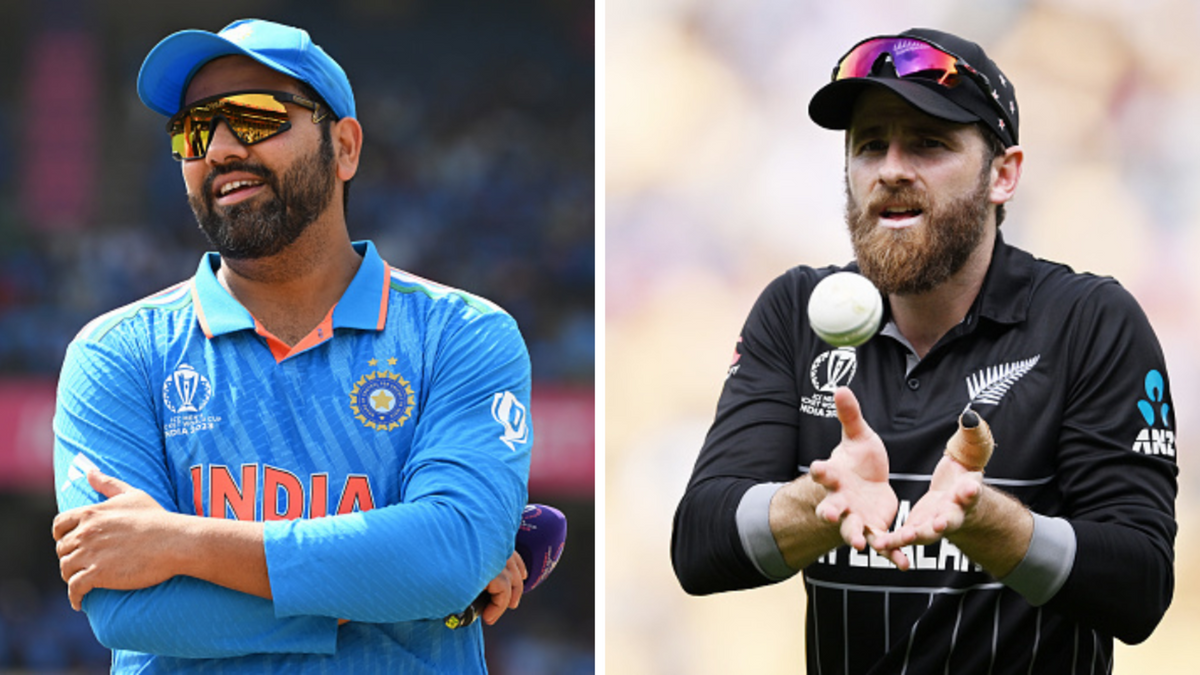
India and New Zealand play each other in the first semi-final of the 2023 World Cup, and here are the key battles that will determine which way the game goes.
To bet on the World Cup with our Match Centre Partners bet365 head here.
The left-arm threat for India’s two biggest stars
The biggest threat for Rohit Sharma will undoubtedly be Trent Boult, the left-armer, who has dismissed the India skipper eight times across all formats. In ODIs, Rohit has fallen to left-handers 33 times, of which 22 have been in the first power play alone.
The opener has a strike rate of 102.3 in the first ten overs in this World Cup, having been dismissed only thrice in that phase. He has batted with aggression throughout the competition, setting the template for the remaining batters early on. But Rohit has a clear weakness, and New Zealand will want to latch on.
Not only Rohit, but Virat Kohli also struggles against the left-arm seamers, having been dismissed 35 times by them. Left-arm pacers have also dismissed Kohli for single-digit scores in the three ODI World Cup semi-finals that he has played – Wahab Riaz in 2011, Mitchell Johnson in 2015 and Boult four years ago and it could be playing on his mind.
India should take on New Zealand’s part-timers
The Black Caps have chosen to go with Mitchell Santner at No.8, which reduces them to only four specialist bowlers, with the fifth-bowler quota being split between Rachin Ravindra and Glenn Phillips. The two were hit for 58 runs combined by India in Dharamsala, and the hosts will look to take them apart at the Wankhede as well, where the spinners might not have much assistance.
India have four batters – Suryakumar Yadav, Shreyas Iyer, Rohit and Gill – who have struck at over 100 between overs 21-39 in this World Cup, which is when the two are likely to bowl. Iyer, who excels against the slower bowlers, averages 127 against the spinners in this phase with a strike rate of 105. He is coming into the game on the back of a hundred and would want to repeat his feat in the crucial game as well.
India’s bowling vs New Zealand’s batting
The New Zealand batters have a strike rate of 103.47 this World Cup, the best among all teams, with a run rate of 6.5, which is also the highest. A total of seven players have struck at over 100 in the tournament, with four also making over 240 runs, combining consistency with big-hitting. The Wankhede Stadium is usually conducive to big hits, and the batters could make merry but they will be up against arguably the best bowling attack.
The Indian bowling attack has an economy rate of 4.5, the best in the competition, and they have also picked up a wicket every 26.2 balls. While the New Zealand batters have looked to arrest collapses, with 13 60-plus partnerships, the India bowlers have prevented big stands, with oppositions only notching up six stands of more than 50 against them.
At this venue, India also shot out Sri Lanka for 50 in the group stage, but the Black Caps will be a tougher rival.
India’s lack of a sixth bowling option
Against the Netherlands, India tried out nine bowling options, a joint-world record, and while it might have invoked laughter with Kohli and then Rohit getting wickets, the reality is not lost on the team that they are just a few big hits away from being a bowler short.
Ever since Hardik Pandya’s injury, Mohammed Shami has been named in the XI. He’s had a stunning World Cup, but that has also meant India field with only five specialist bowlers, with paper-thin sixth-bowling options available.
In the India-New Zealand league game, Daryl Mitchell was particularly harsh on Kuldeep Yadav, hitting him for straight sixes while also sweeping and playing the reverse sweeps against him. Kuldeep had gone for 73 runs in the game, and while Shami ensured the target was within 275 with a five-wicket haul, a bad day for a bowler will leave the team reeling, increasing the pressure on the others while also leaving them looking around for a batter who could roll his arm over economically. Siraj also hasn’t been at his best in the World Cup, being wayward with his line and lengths, and a repeat could be mayhem.
The toss could be a big factor
The toss will be a big factor at the Wankhede Stadium, even though India skipper Rohit denied its importance. In the first 20 overs of all games at the venue in this World Cup, the quicks have generally struggled in the first 20 overs, while they have found more swing and help in the same stage in the second innings under lights.
The importance of toss at Wankhede:
Pace bowlers in Overs 1-20
Innings 1: 4 wickets at 71 runs per wicket
Innings 2: 26 wickets at 11 runs per wicket— Alagappan Vijayakumar (@IndianMourinho) November 14, 2023
The trend of collapses while chasing is also hard to miss. England were 68-5 in the second innings against South Africa, Bangladesh were reduced to 81-5 against the Proteas in the second game at the Wankhede, while Sri Lanka and Australia’s scorecards read 14-6 and 91-7 against India and Afghanistan, respectively. Only Australia won chasing at Mumbai this World Cup, courtesy of a manic knock from Glenn Maxwell, but it is safe to say the coin flip could prove to be a major factor, with both teams having quicks that would make the most of the conditions in the second half.








